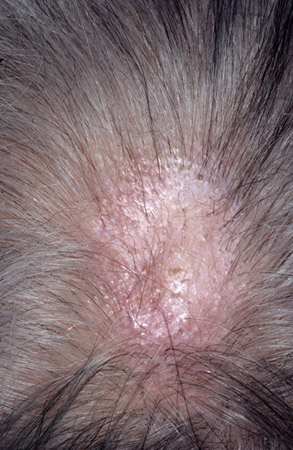Complications
Oral LP can make eating painful. In severe cases, this may lead to malnutrition.[55]
Hyperpigmentation is common after lesions resolve, particularly in people with darker skin.[55]
As a form of scarring alopecia, lichen planopilaris (lichen planus of the scalp) can result in permanent alopecia at the involved site.[Figure caption and citation for the preceding image starts]: Lichen planopilarisMayo Clinic clinical photographs (used with permission). [Citation ends].
Scarring from ungual LP may result in loss of the nail plate.[55] Erosive oral or genital LP can also lead to scarring.
In erosive vulvovaginal LP, adhesions and scarring may develop as erosions heal.[28][46][51] In women with vaginal involvement, this can eventually result in complete vaginal stenosis.
Vulvar scarring and adhesions are thought to be more common, with reported rates ranging from 42% to 95%.[50] There are limited data on rates of vaginal adhesions and stenosis, but studies suggest that adhesions may occur in 10% to 50%.[50]
The American College of Obstetricians and Gynecologists guideline recommends graded vaginal dilators in conjunction with intravaginal topical corticosteroids to prevent vaginal adhesions and stenosis.[28]
Surgical treatment may be required for patients with symptomatic scarring and adhesions, but it is contraindicated during active, inflammatory disease.[28][46]
Although there have been reports of cutaneous squamous cell carcinoma developing in lichen planus (LP) lesions, there is no proven association.[96]
Genital LP is believed to increase the risk of local squamous cell carcinoma, although the contribution of oral LP to oral malignancy is controversial.[97][98] One systematic review reported an absolute risk of developing vulvar squamous cell carcinoma of 1.16% in patients with LP.[99] The estimated malignant transformation rate for oral LP ranges from 0.2% to 1.4% in meta-analyses.[100][101]
Concerns have been expressed regarding the potential of tacrolimus to encourage malignant transformation of the mucosa, though the evidence for this is very limited.[79] It is important to monitor patients treated with topical calcineurin inhibitors, particularly those with erosive and ulcerative lesions.
Use of this content is subject to our disclaimer